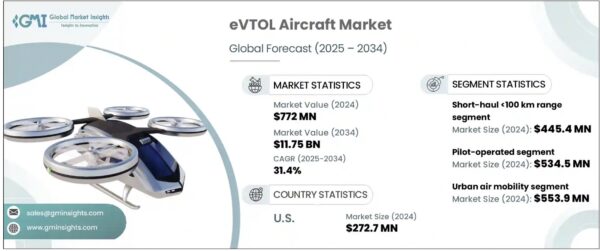Polymers Take Flight: How Plastics Are Powering eVTOL Design

eVTOL aircraft are a significant step forward for urban mobility, but their success hinges on a critical challenge: weight reduction. Advanced polymers and composites are the materials making this possible.
Electric vertical takeoff and landing (eVTOL) aircraft race from concept sketches to functional prototypes. They promise quiet, low-emission transport that bypasses traffic in cities where congestion has become unmanageable. While propulsion and battery systems often dominate the conversation, the success of this new mobility sector relies just as much on the materials that hold these aircraft together. Polymers and polymer composites are emerging as the enablers of eVTOL design, providing weight reduction, safety, manufacturability, and sustainability advantages that metals alone cannot match.
You can also read: Demand Materializes For Electric Urban Air Mobility Vehicles And Materials.
Weight Reduction Through Advanced Polymers
Weight is the decisive factor for range, payload, and efficiency in electric flight. Advanced polymers bring densities in the range of 1.1–1.6 g/cm³, far below that of aluminum at 2.7 g/cm³, while maintaining mechanical properties. High-performance polymers such as polyamide-imide (PAI), polyetheretherketone (PEEK), polyetherimide (PEI), and polyimides deliver strength, stiffness, and heat resistance that meet aerospace standards. For instance, PAI grades like TORLON® maintain compressive strengths above 250 MPa and operate at 260 °C without losing stability. PEEK combines tensile strength of around 150 MPa with fatigue and chemical resistance, making it suitable for load-bearing brackets and housings. Polyimides such as VESPEL® withstand peak temperatures above 480 °C, supporting propulsion and battery systems integration. When reinforced with carbon fibers, thermoplastic composites achieve stiffness-to-weight ratios suitable for primary structures while cutting component mass nearly in half compared to aluminum.
Cabin and Glazing Systems
The cabin environment presents a different set of challenges where polymers again lead. Transparency and safety must coexist in passenger windows and canopies, so optical-grade polycarbonate has become preferred. It offers impact resistance up to 200 times higher than glass, reducing glazing weight by 30–50%. Aerospace polycarbonate grades also meet stringent flame, smoke, and toxicity standards such as FAR 25.853, making them viable for passenger cabins. Inside the aircraft, lightweight foams based on polyurethane or silicone play a critical role in acoustic damping, reducing cabin noise by 10–15 dB in the frequency range of rotor blades. Engineering thermoplastics also enable integrated seating systems and ducting components, where flame-retardant polyamides can substitute aluminum.
Battery Protection and Thermal Management
Energy storage and power systems demand new polymer innovations, since performance, safety, and manufacturability must all align in electric aviation. Therefore, designers increasingly use fiber-reinforced thermoplastics for battery enclosures, because they enable complex geometries like cooling channels directly molded into structures. This integration reduces assembly steps, lowers overall weight, and simultaneously ensures adequate fire performance, thereby improving efficiency and passenger safety. Moreover, polyimide films act as dielectric separators in high-voltage batteries, maintaining structural and electrical integrity at temperatures above 200 °C. In addition, silicone- and urethane-based foams provide protective barriers, absorbing vibration and impact while maintaining resilience across wide temperature ranges. Intumescent polymer coatings add critical protection, swelling under heat into insulating barriers that delay flame propagation during thermal runaway.
Manufacturing Scalability
The shift from traditional aerospace to urban air mobility also demands a rethink of manufacturing methods. Manufacturers measure conventional aircraft production in hundreds of units per year, while eVTOL programs target thousands. Polymers and thermoplastic composites align with this industrial scale. Automated tape placement, compression molding, and injection overmolding enable cycle times measured in minutes, compared to the hours required for thermoset curing. Thermoplastics can also undergo welding and reprocessing, which both reduces assembly complexity and enables recyclability pathways that thermoset composites lack. Suppliers including Solvay, Teijin, Arkema, and Toray are expanding aerospace-grade thermoplastic lines specifically to serve this demand.
Certification and Safety Performance
Certification remains one of the toughest hurdles for the industry. All materials used in the cabin and structural components must pass flame, smoke, and toxicity standards. Researchers formulate high-performance polymers with inherent flame resistance, often achieving limiting oxygen indices above 35%, which reduces reliance on halogenated additives. Another challenge is damage tolerance. At low altitudes over cities, eVTOLs must withstand impacts from bird strikes or rotor debris. Carbon fiber thermoplastics outperform thermosets in this respect, showing up to 30% higher impact toughness, which improves resilience in urban operating environments.
Toward Sustainable Urban Air Mobility

eVTOL Aircraft Market. Courtesy of Global Market Insights.
Beyond improving performance, polymers also help achieve the sustainability goals of electric aviation. Bio-derived materials, like polyamides and PEKKs, help reduce the overall carbon footprint. Additionally, some thermoplastics require far less energy to recycle than aluminum, which consumes up to 95% more energy per kilogram.
With over a dozen developers preparing for commercial launches before 2030, the eVTOL market is on a stunning growth trajectory. According to Global Market Insights, the global market value will soar from $772 million in 2024 to $11.75 billion by 2034, representing a compound annual growth rate (CAGR) of 31.4%. This rapid expansion underscores the urgency and scale demanded for manufacturing these vehicles.
Polymers have already moved from secondary components into structural, safety-critical, and recyclable roles. As eVTOLs begin to rise into the skies above our cities, plastics will be as essential to their success as the batteries and rotors that lift them.
